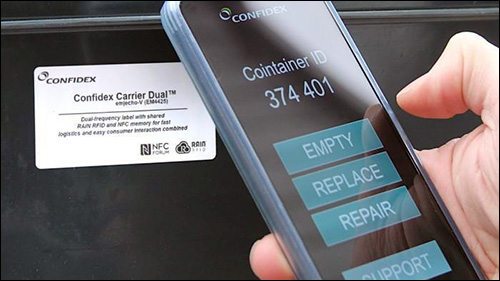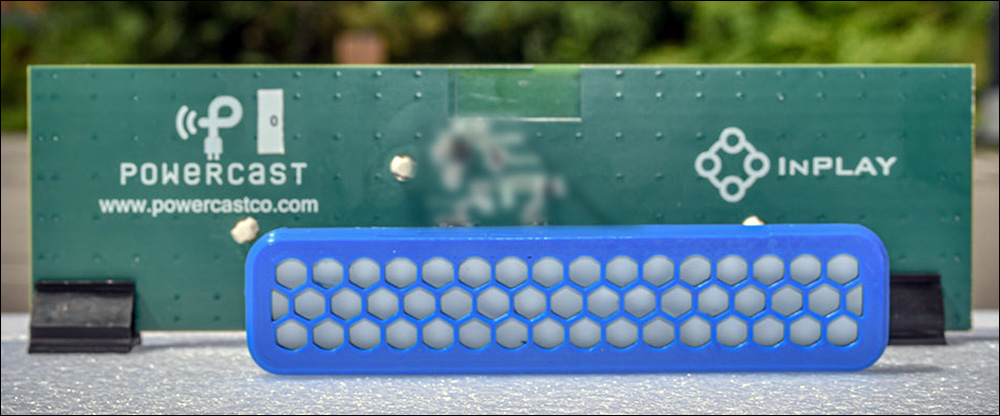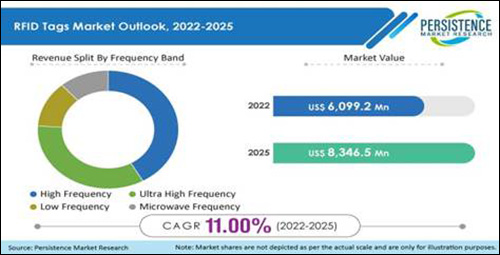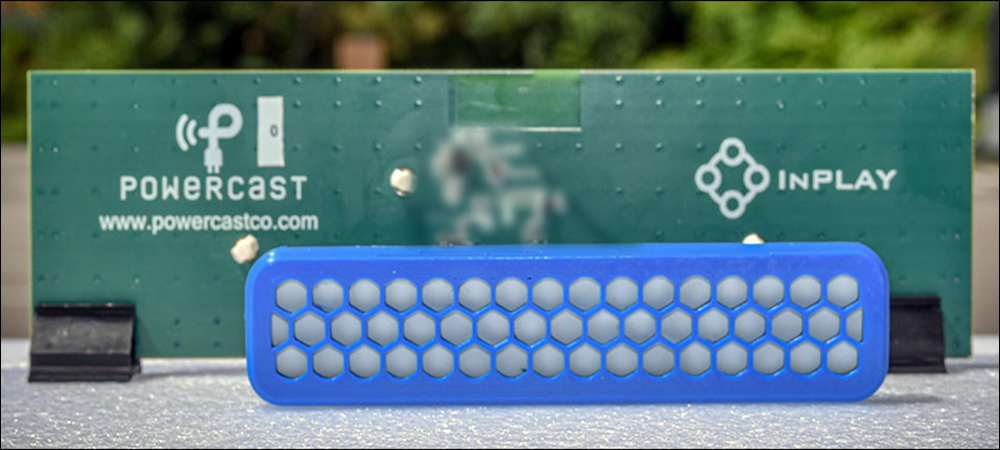- Confidex Releases Label with Shared RFID and NFC Memory
- Powercast, InPlay Offer Battery-free BLE Sensor Beacon
- Study Shows Strong RFID Tag Market Growth
- AI Company Altair Launches IoT Data-Analytics Appliance
Presented here are recent news announcements in the radio frequency identification and Internet of Things industries.
Confidex Releases Label with Shared RFID and NFC Memory
To help industrial and retail businesses uniquely identify goods from cradle to grave, Confidex has released a new label with shared memory for both ultrahigh-frequency (UHF) RFID and Near Field Communication (NFC). The company’s Carrier Dual label, part of its Carrier product family for washable returnable transit items (RTIs), can store critical data and transmit it via both interfaces on a single IC. The label leverages EM Microelectronic‘s em|echo-V (EM4425) IC, and users can access the same unique information about a product or asset via an RFID or NFC reader or mobile phone.

The Confidex Carrier Dual label
The RFID interface builds on existing infrastructure, the company reports, adding NFC to enable consumer interaction and remove tag-reading barriers. The Carrier Dual is sized at 70 millimeters by 36 millimeters (2.75 inches by 1.41 inches), making it suitable for reusable pallets or consumer goods packaging. The label can be applied for applications in the industrial sector, including with reusable transport items. It enables the encoding of both RFID and NFC memory via RFID printers, allowing users to encode NFC data such as website addresses with an existing printer setup.
According to Confidex, users can capture data throughout a supply chain, counting inventory at warehouses or stores via RFID, while those without RFID readers can rely on NFC-enabled mobile phones to access the same information. Brand protection, inventory management and consumer engagement can be integrated with a single label that can be interrogated throughout the supply chain via RFID, then be used by consumers for product details and rewards.
Consumers can verify the authenticity and integrity of purchased items, such as pharmaceuticals, by reading the same tags used to ensure supply chain efficiency, and retailers can do the same with returned products by capturing data via a smartphone. Expiration dates, manufacturing details and product ingredients can be stored in a label built directly into a consumer package.
Powercast, InPlay Offer Battery-free BLE Sensor Beacon
Powercast, a provider of RF-based over-the-air wireless power technologies, and InPlay, which offers NanoBeacon programming-free, low-power Bluetooth sensor systems-on-chip (SoCs), have forged a partnership. The two companies will work together to create a platform for designing battery-free, maintenance-free, long-range wireless Internet of Things (IoT) sensor solutions for monitoring items in the retail, medical, warehousing and Industrial IoT markets.

The battery-free BLE sensor beacon
Powercast’s RF-to-DC power-harvesting technology is a new option to power InPlay’s IN100 active Bluetooth sensor. The IN100 can be attached to assets for real-time location monitoring, and it can be paired with sensors to monitor light, humidity and temperature levels. Capable of powering sensors at a range of more than 80 feet, Powercast’s far-field wireless technology now powers the NanoBeacon IN100 from 120 feet away from the commercially available PowerSpot transmitter. This, according to the companies, enables a beacon signal every minute.
The NanoBeacon’s design allows fast start-up and data transmission using microwatts of power, the partners explain. As the NanoBeacon moves farther from Powercast’s RF transmitter, signals become less frequent, while moving it closer allows greater frequency. This distance achievement is due to Powercast’s new reference design for its PCC110 Powerharvester chip and companion PCC210 boost converter, which harvest RF out of the air with up to 75 percent efficiency.
The NanoBeacon SoC family is designed for use with smart sensor systems employing active RFID and Bluetooth Low Energy (BLE) technologies. It can be configured via an app, requires no software programming, transmits data at a distance of up to 300 feet and features software-defined radio (SDR) edge networking to connect tens of thousands of IoT devices. “Maintaining billions of battery-powered IoT devices in the field is an expensive challenge, but with Powercast’s technology, our customers can design battery-free wireless sensors to avoid downtime and maintenance issues,” said Jason Wu, InPlay’s cofounder and CEO, in a prepared statement.
Study Shows Strong RFID Tag Market Growth
Persistence Market Research (PMR) has released a new report indicating that the global market size for RFID tags is expected to surpass nearly $8.35 billion in terms of market value by 2025, moving steadily at a compound annual growth rate of 11 percent from 2022 to 2025. The study is available at the company’s website.

The research predicts strong market growth for RFID tags.
“RFID technology has radically changed the way businesses operate,” PMR explains. “It has boosted operational efficiency, improved asset tracking and visibility, reduced costs, [and] improved reliability and supply chain visibility. RFID tags are increasingly being used in the industrial sector for asset management and quality control, which is expected to push the market forward. Many radio frequency identification (RFID) tag applications are also emerging within the retail sector. RFID tags are being used in the retail sector, including fashion, to increase inventory availability and improve customer experience.”
According to PMR, the Asia Pacific region is likely to have a substantial share of the market and grow significantly during the forecast period. “The rapidly growing installation of these RFID systems in manufacturing units to boost efficiency has considerably fueled the market growth in the region,” the company adds. “The increasing acceptance of electronic identity cards and RFID tags embedded in smart cards are also propelling the region’s RFID market forward.”
Aspects contributing to this market growth, PMR notes, include the growing retail sector, along with increased retailer focus on integrating digital technologies to improve the shopping experience and optimize warehouse-management processes. The public transportation sector is likely to be among the areas in which the market will grow throughout the forecast period in the Asia Pacific region, the company says, and RFID use is also likely to increase in India.
“Due to the COVID-19 outbreak, healthcare facilities all across the world were overloaded with patients, necessitating the development of comprehensive patient management and tracking systems,” PMR adds. “RFID technology played an important role in the global digitalization of healthcare facilities. RFID tags helped to limit the spread of the novel coronavirus by supporting healthcare staff and personnel with social distancing guidelines, tracking patient and staff location, and preventing non-patients from infecting hospital staff.”
AI Company Altair Launches IoT Data-Analytics Appliance
Altair, a provider of computational science and artificial intelligence (AI) technologies, has announced the launch of its Altair Unlimited data-analytics appliance, designed to democratize enterprise-wide data analytics and enable users to glean data insights. The appliance is built on Dell‘s PowerEdge R750 servers, the company reports, and is built to foster data-driven strategies enterprise-wide.
Altair Unlimited offers access to the Altair Analytics software package, including Altair SLC, Altair SmartWorks Hub, Altair Analytics Workbench, Altair SmartWorks and Altair Access. Organizations can develop and run multi-language data-analytics software solutions, including those written in the SAS language. The appliance supports interactive use by data scientists and business users, with a secure, managed production-deployment infrastructure for scheduled and on-demand operation.
According to an Altair spokesperson, “The advantage for the IoT is that it will help engineers and other application design and integration teams break down silos and democratize enterprise-wide data analytics so users can glean more data insights from their IoT applications. The Altair Unlimited data-analytics appliance gives users pre-loaded access to the Altair Analytics software package and additional solutions, one of which is Altair SmartWorks, which helps customers create scalable, secure IoT and data-analytics applications faster, more efficiently and more cost-effectively. Using Altair, users throughout the organization can develop custom analytics/end-user applications, train and evaluate AI models, explore data trends, and spot anomalies, deploy models on-premises, in the cloud, or from hybrid workflows, and more.”


